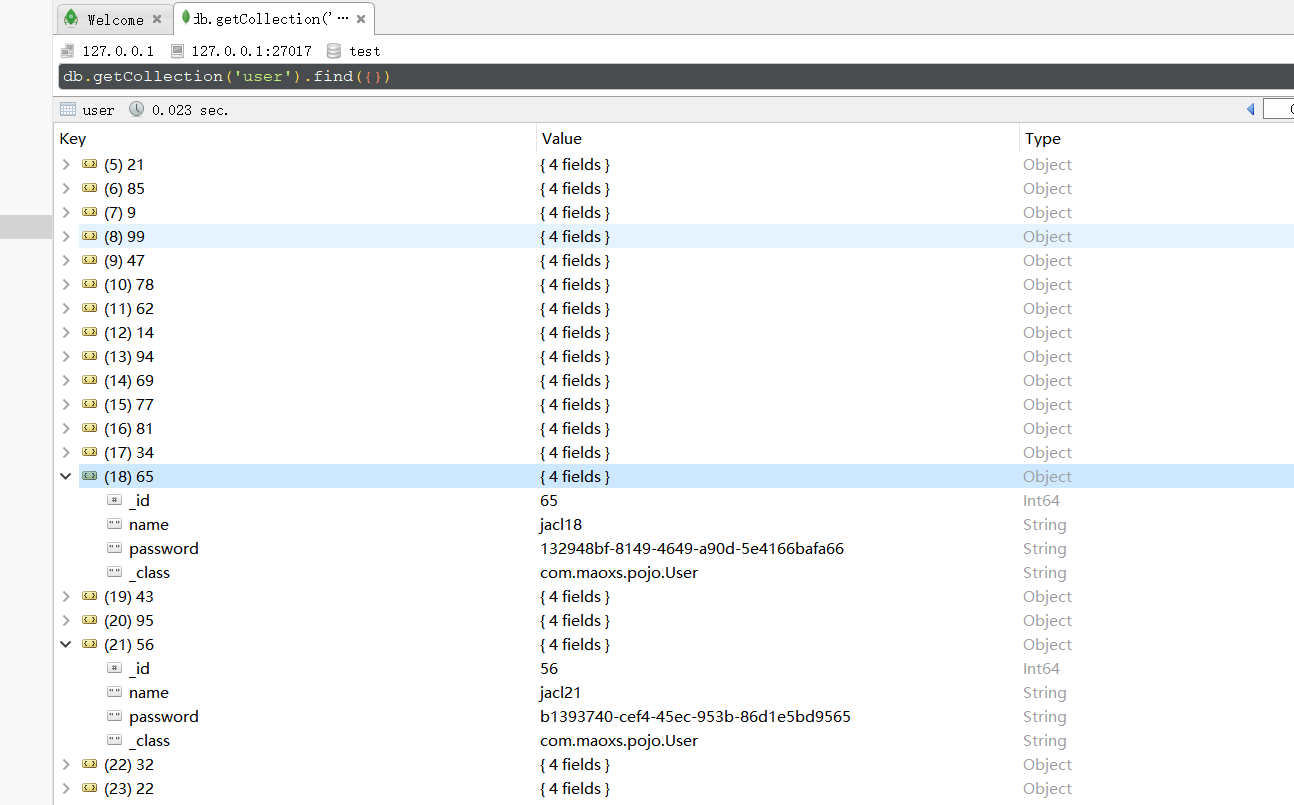Nosql的全称是Not Only Sql,这个概念早起就有人提出,在09年的时候比较火。Nosql指的是非关系型数据库,而我们常用的都是关系型数据库。就像我们常用的mysql,sqlserver一样,这些数据库一般用来存储重要信息,应对普通的业务是没有问题的。但是,随着互联网的高速发展,传统的关系型数据库在应付超大规模,超大流量以及高并发的时候力不从心。而就在这个时候,Nosql得到的告诉的发展。
这里要说明我只用过两种nosql,今天就放上去springboot对他们的一些配置
Redis
先添加依赖
<dependency>
<groupId>org.springframework.boot</groupId>
<artifactId>spring-boot-starter-data-redis</artifactId>
</dependency>
这里需要说明一下
首先呢看下yml的配置
spring:
redis:
host: 127.0.0.1
port: 6379
password:
jedis:
pool:
max-active: 9
max-idle: 8
max-wait: -1ms
min-idle: 0
database: 0 # 指定存储的数据是哪个库
如果集群了咋办呢 添加如下配置 这里要修改
spring:
redis:
host: 192.168.8.132
port: 6379
timeout: 20000
cluster:
nodes: 192.168.8.134:7000,192.168.8.134:7001,192.168.8.134:7002
maxRedirects: 6
pool:
max-active: 8
min-idle: 0
max-idle: 8
max-wait: -1
springboot 使用的是RedisTemplate 来简化操作,这里建议提前配置一下主要是对序列化的处理
package com.maoxs.conf;
import com.fasterxml.jackson.annotation.JsonAutoDetect;
import com.fasterxml.jackson.annotation.PropertyAccessor;
import com.fasterxml.jackson.databind.ObjectMapper;
import org.springframework.context.annotation.Bean;
import org.springframework.context.annotation.Configuration;
import org.springframework.data.redis.connection.RedisConnectionFactory;
import org.springframework.data.redis.core.RedisTemplate;
import org.springframework.data.redis.core.StringRedisTemplate;
import org.springframework.data.redis.serializer.Jackson2JsonRedisSerializer;
import org.springframework.data.redis.serializer.StringRedisSerializer;
/**
* Redis缓存配置
*
* @author FuLin
*/
@Configuration
public class RedisConfig {
// 以下两种redisTemplate自由根据场景选择
@Bean
public RedisTemplate<Object, Object> redisTemplate(RedisConnectionFactory connectionFactory) {
RedisTemplate<Object, Object> template = new RedisTemplate<>();
template.setConnectionFactory(connectionFactory);
//使用Jackson2JsonRedisSerializer来序列化和反序列化redis的value值(默认使用JDK的序列化方式)
Jackson2JsonRedisSerializer serializer = new Jackson2JsonRedisSerializer(Object.class);
ObjectMapper mapper = new ObjectMapper();
mapper.setVisibility(PropertyAccessor.ALL, JsonAutoDetect.Visibility.ANY);
mapper.enableDefaultTyping(ObjectMapper.DefaultTyping.NON_FINAL);
serializer.setObjectMapper(mapper);
template.setValueSerializer(serializer);
//使用StringRedisSerializer来序列化和反序列化redis的key值
template.setKeySerializer(new StringRedisSerializer());
template.afterPropertiesSet();
return template;
}
@Bean
public StringRedisTemplate stringRedisTemplate(RedisConnectionFactory factory) {
StringRedisTemplate stringRedisTemplate = new StringRedisTemplate();
stringRedisTemplate.setConnectionFactory(factory);
return stringRedisTemplate;
}
}
使用的时候用@Autowrid 注入即可 切记存入redis的类一定要实现Serializable 接口,不然在流的传输中会受到影响。这里就不演示怎么使用了以后我会出使用帖子 这里放个学习手册 RedisTemplate 学习手册
mongodb
依赖依赖依赖
<dependency>
<groupId>org.springframework.boot</groupId>
<artifactId>spring-boot-starter-data-mongodb</artifactId>
</dependency>
然后呢yml
spring:
data:
mongodb:
uri: mongodb://localhost:27017/test #如果没有test就会自动创建
集群呢就这样写
spring:
data:
mongodb:
uri: mongodb://192.168.8.101:27017,192.168.8.101:27018/test #如果没有test就会自动创建
有密码了怎么办
spring:
data:
mongodb:
uri: mongodb://user:[email protected]:27017/test #如果没有test就会自动创建
springboot中是使用MongoTemplate 来简化操作的。写个简单的例子 创建一个实体类
package com.maoxs.pojo;
import java.io.Serializable;
public class User implements Serializable {
private Long id;
private String name;
private String password;
public User(Long id, String name, String password) {
this.id = id;
this.name = name;
this.password = password;
}
public Long getId() {
return id;
}
public String getName() {
return name;
}
public String getPassword() {
return password;
}
@Override
public String toString() {
final StringBuffer sb = new StringBuffer("User{");
sb.append("id=").append(id);
sb.append(", name='").append(name).append('\'');
sb.append(", password='").append(password).append('\'');
sb.append('}');
return sb.toString();
}
}
package com.maoxs.dao;
import com.maoxs.pojo.User;
import java.util.List;
public interface UserDao {
void add(User user) throws Exception;
void update(User user) throws Exception;
void delete(Long id) throws Exception;
List<User> select(int page, int size)throws Exception;
}
package com.maoxs.dao.impl;
import com.maoxs.dao.UserDao;
import com.maoxs.pojo.User;
import org.springframework.beans.factory.annotation.Autowired;
import org.springframework.data.mongodb.core.MongoTemplate;
import org.springframework.data.mongodb.core.query.Criteria;
import org.springframework.data.mongodb.core.query.Query;
import org.springframework.data.mongodb.core.query.Update;
import org.springframework.stereotype.Service;
import java.util.List;
@Service
public class UserDaoImpl implements UserDao {
@Autowired
private MongoTemplate mongoTemplate;
/**
* 添加
* @param user
* @throws Exception
*/
@Override
public void add(User user) throws Exception {
mongoTemplate.save(user);
}
/**
* 根据id更新
* @param user
* @throws Exception
*/
@Override
public void update(User user) throws Exception {
Query query = new Query(Criteria.where("id").is(user.getId()));
Update update = new Update().set("name", user.getName()).set("password", user.getPassword());
mongoTemplate.updateFirst(query, update, User.class);
}
/**
* 删除
* @param id
* @throws Exception
*/
@Override
public void delete(Long id) throws Exception {
Query query = new Query(Criteria.where("id").is(id));
mongoTemplate.remove(query,User.class);
}
/**
* 分页
* @param page
* @param size
* @return
* @throws Exception
*/
@Override
public List<User> select(int page,int size) throws Exception {
Query query = new Query();
query.skip(page*size).limit(size);
List<User> users = mongoTemplate.find(query, User.class);
return users;
}
}
然后是测试类
package com.maoxs;
import com.maoxs.dao.UserDao;
import com.maoxs.pojo.User;
import org.junit.Assert;
import org.junit.Test;
import org.junit.runner.RunWith;
import org.springframework.beans.factory.annotation.Autowired;
import org.springframework.boot.test.context.SpringBootTest;
import org.springframework.test.context.junit4.SpringRunner;
import java.util.List;
import java.util.Random;
import java.util.UUID;
@RunWith(SpringRunner.class)
@SpringBootTest
public class SpringbootMongodbApplicationTests {
@Autowired
private UserDao userDao;
@Test
public void add() throws Exception {
Random rand = new Random();
for (int i = 1; i <= 50; i++) {
User user = new User(rand.nextInt(100) + 1L, "jacl" + i, UUID.randomUUID().toString());
userDao.add(user);
}
}
@Test
public void update() throws Exception {
User user = new User(79L, "fulin", "wangle");
this.userDao.update(user);
}
@Test
public void del() throws Exception {
this.userDao.delete(5L);
}
@Test
public void selcet() throws Exception {
List<User> select = this.userDao.select(1, 10);
select.forEach(p -> {
System.out.println(p.toString());
});
}
}
在用robo看看效果
在用robo看看效果
ok没问题 这里呢在放一个学习手册 MongoTemplate 学习手册
本博文是基于springboot2.x 如果有什么不对的请在下方留言。
相关连接:
个人博客地址 : www.fulinlin.com
csdn博客地址:https://blog.csdn.net/qq_32867467
集合源码地址 : https://gitee.com/Maoxs/springboot-test
注:如果不对联系本宝宝及时改正~~
